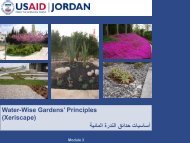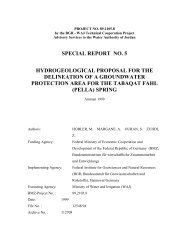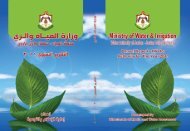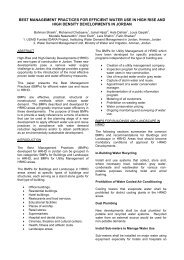Delineation of Groundwater Protection Zones for the Hallabat Wellfield
Delineation of Groundwater Protection Zones for the Hallabat Wellfield
Delineation of Groundwater Protection Zones for the Hallabat Wellfield
Create successful ePaper yourself
Turn your PDF publications into a flip-book with our unique Google optimized e-Paper software.
Executive Summary<br />
The <strong>Hallabat</strong> wellfield, located in <strong>the</strong> nor<strong>the</strong>astern part <strong>of</strong> Jordan, about 26 km<br />
east <strong>of</strong> Zarqa, is an important source <strong>for</strong> water supply <strong>of</strong> Amman and Zarqa as<br />
well as <strong>for</strong> <strong>the</strong> local villages. A total <strong>of</strong> 29 wells currently provide 4 MCM/a from<br />
<strong>the</strong> basalt and A7/B2 aquifers.<br />
Because <strong>of</strong> its importance <strong>the</strong> German-Jordanian Technical Cooperation project<br />
“<strong>Groundwater</strong> Resources Management” has chosen this wellfield as one <strong>of</strong> its<br />
working areas <strong>for</strong> <strong>the</strong> delineation <strong>of</strong> groundwater protection zones according to<br />
<strong>the</strong> issued Jordanian "Guidelines <strong>for</strong> Drinking Water Resources <strong>Protection</strong>"<br />
(July 2006). The proposed groundwater protection area has been fur<strong>the</strong>r<br />
subdivided into three zones, which require different degrees <strong>of</strong> landuse<br />
restrictions.<br />
During <strong>the</strong> field work to this report several risks to <strong>the</strong> drinking water supply<br />
provided by <strong>the</strong> <strong>Hallabat</strong> wellfield were identified. They partly arise from deficits<br />
in <strong>the</strong> construction and upkeep <strong>of</strong> <strong>the</strong> water supply infrastructure, from a lack <strong>of</strong><br />
access barriers to <strong>the</strong> protection zone 1 (partly missing fences), from a lack <strong>of</strong><br />
awareness <strong>of</strong> <strong>the</strong> guards (free access to protection zone 1 through open gate)<br />
and from pollution risks in zone 2.<br />
Because some <strong>of</strong> <strong>the</strong> wells have already been affected by bacteriological<br />
contamination, <strong>the</strong> report proposes several corrective measures in order to<br />
reduce <strong>the</strong> contamination risk <strong>of</strong> <strong>the</strong> drinking water source. It is important that<br />
<strong>the</strong>se measures are implemented as soon as possible. Concerning protection<br />
zone 1 WAJ will have to enlarge <strong>the</strong> well perimeter so that <strong>the</strong> distance from <strong>the</strong><br />
well to <strong>the</strong> fence will always be 25 m, as required by <strong>the</strong> guideline. WAJ also<br />
should install an overlapping well cap with a conduit box to avoid direct access<br />
to <strong>the</strong> well, repair <strong>the</strong> damaged pipe network and physically block entrance to<br />
<strong>the</strong> installations. WAJ employs guards <strong>for</strong> groups <strong>of</strong> wells. They usually live<br />
right next to a well from where <strong>the</strong>y take electricity and water. But <strong>the</strong>y also<br />
grow crops, raise animals and dispose <strong>of</strong> <strong>the</strong>ir wastewater in too close vicinity <strong>of</strong><br />
<strong>the</strong> wells. Proper wastewater collection systems should be installed <strong>for</strong> <strong>the</strong>se<br />
guards at a distance <strong>of</strong> not less than 100 m from <strong>the</strong> well. These must be<br />
regularly emptied. Moreover, <strong>the</strong> guards must be taught not to keep <strong>the</strong>ir<br />
animals or grow crops at distances less than 100 m from <strong>the</strong> wells.<br />
A number <strong>of</strong> corrective measures have also been proposed <strong>for</strong> protection zones<br />
2, where <strong>the</strong> most prominent contamination risks arise from agricultural and cow<br />
farming activities. Implementation <strong>of</strong> <strong>the</strong>se measures should be given high<br />
priority. A spreading <strong>of</strong> cow farming, which is currently mainly concentrated<br />
around <strong>the</strong> village Ad Dhuleil, towards <strong>the</strong> <strong>Hallabat</strong> or Corridor wellfields should<br />
be avoided under all circumstances and strongly objected by <strong>the</strong> MWI and WAJ.<br />
In collaboration with <strong>the</strong> Ministry <strong>of</strong> Environment a solution must be found<br />
urgently concerning <strong>the</strong> safe storage and disposal or treatment <strong>of</strong> cow dung. In<br />
<strong>the</strong> focus <strong>of</strong> such a solution should be <strong>the</strong> need <strong>for</strong> protection <strong>of</strong> <strong>the</strong><br />
groundwater resources.<br />
Ano<strong>the</strong>r main threat to <strong>the</strong> drinking water resources is <strong>the</strong> inappropriate storage<br />
and disposal <strong>of</strong> untreated wastewater. There is currently no public wastewater<br />
collection and treatment system in <strong>the</strong> area. It is recommended that WAJ







